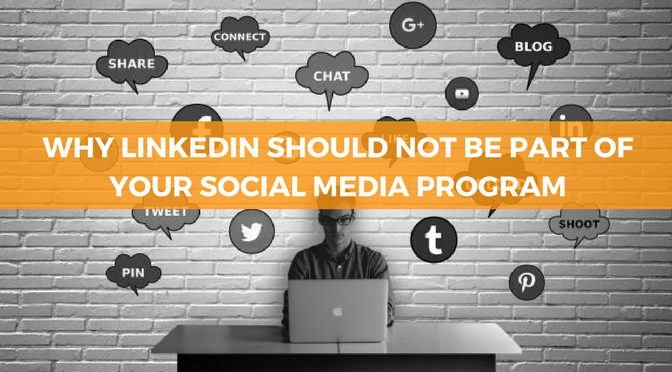Why LinkedIn Should Not Be Part of Your Social Media Program
B2B social media programs are dangerous in the wrong hands. And most of them are in the wrong hands.
Having a formal social media program can easily lull you into the false belief that you’re getting the best possible value out of every network. After all, you’re got all those social media icons on your website. You’re publishing updates to your company pages every day, if not more often. You’re promoting your marketing content. You’re driving traffic to your website (although you may have no idea if it’s actually good traffic or not). You’re measuring likes, shares and comments - and you think you’ve got it all covered.
I’ve found this is usually not the case - especially with LinkedIn. And by lumping LinkedIn into a conventional social media program, you are missing out on a critical communication channel that plays a key role in a majority of purchasing decisions. It’s almost as if your sales team decided not to use the phone.
What most B2B social media programs miss
The typical B2B program treats social media like a broadcast channel, using status updates to push out content, announcements, and photos of the firm’s latest event. This approach lays an important foundation for supporting the brand’s image online and theoretically increasing visibility, but it assumes buyers are actively visiting your company page or searching their newsfeeds just to see what you’re posting.
How many of us can count on that?
Where LinkedIn is different
At its heart, LinkedIn is a one-to-one business network - not much different from an offline event. Just way bigger and easier to get to.
People go to LinkedIn to connect with other people. This is why LinkedIn tells us individual profiles, on average, get 8X more engagement than company pages.
But just posting on your personal profile isn’t enough either. Success on LinkedIn means reaching out individually to relevant members with relevant messages. It means commenting and sharing what others post. It’s a conversation - not a monologue.
And it’s a chance to begin to grow real relationships.
Does LinkedIn really matter?
Over the past several years LinkedIn has become a key communication channel for business professionals. Buyers and decision makers use it to learn about their challenges, research potential solutions, and get expert advice. They are educating themselves on LinkedIn long before they will respond to a conventional sales approach.
In the early stages of a complex buying process, buyers are not interested in specific vendors and branded information, They will not be looking at your company page. If they aren’t connected to or following you personally, your status updates and articles will not show up in their news feeds (even if they happen to be looking). As buyers do their initial research, they may not find you. They may find your competitor instead.
At best, most B2B companies are investing money in LinkedIn via a social media program and not getting much for their efforts. The greater danger is that they are unknowingly missing out on one of today’s most important business communications channels.
What needs to happen?
To take advantage of the huge opportunity offered by LinkedIn, I suggest business leaders and marketing people need to think beyond a typical social media approach. In fact, I suggest you not even think of LinkedIn as social media. Think of it instead as a business development tool. One you can use to drive qualified leads, increase your pipeline and shorten time-to-sale.
It starts by taking the time to do some thinking and planning. We generally spend six weeks putting together a LInkedIn strategy and plan, with solid business results once the program is implemented.
During that six weeks we take business-supporting objectives, market and competitive data and map them to seven tactics I’ve found critical for “owning” LinkedIn. At the end, we have a plan for reaching those objectives with a sustainable, scalable and constantly improving program.
The mechanics of LinkedIn are not difficult to understand, and the “doers” capable of efficiently executing a program are neither expensive nor hard to find. They are available the world over through the ever-growing freelance economy. They are in your offices in the form of interns and entry level marketing people.
To develop a functional strategy and build a sustainable program that continues to deliver the results your business needs to grow requires more than just a familiarity with social media - more than knowing how to post a status update. It requires experience and understanding of B2B sales and marketing, So look beyond the typical social media sources to find the people who can make your LinkedIn presence deliver results.
LinkedIn makes it remarkably easy to identify your ideal prospects. It gives you a channel to connect, engage and begin to build relationships with them. It lets you build legitimate thought leadership platforms for your subject matter experts to help educate your prospects.
But you won’t get all that just posting on your company page.

